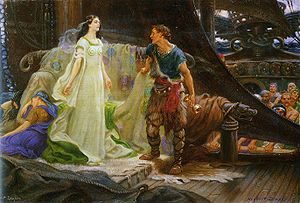Iseult is the titular character from the Arthurian legend Tristan and Iseult, which has its roots in celtic myth. She was an Irish princess, daughter of King Anguish and Queen Iseult the Elder. Tristan is the nephew of Mark of Cornwall, and a Cornish knight of the Round Table.
Tristan is an orphan who becomes a favourite at his uncle King Mark of Cornwall’s court. He works hard for his favour and defeats the Irish challenger Morholt who came to demand tribute, when he kills him he leaves a chip of his sword in Morholt’s head.
When he arrives in Ireland later on to arrange a marriage between Iseult and his uncle Mark of Cornwall, Iseult realises he is the one who killed her uncle Morholt, due to the piece in her uncles head matching that of Tristan’s sword. She is furious but still accepts the proposal of Mark of Cornwall. Tristan and Iseult depart by boat back to Cornwall for the marriage.
On the boat Tristan and Iseult accidentally consume a love potion, which had been prepared by Iseult’s mother and given to Iseult’s lady-in-waiting Brangaine for safe keeping. It was a love potion intended for Iseult and Mark on their wedding night. Unfortunately the potion worked on Tristan and Iseult and they fell in love on the boat and begin an affair.
Iseult loses her virginity to Tristan on the boat and so convince’s her lady-in waiting to take her place on her wedding knight. There then goes a period where Tristan and Iseult are at court conducting their love affair in secret, however people begin to get suspicious but there is never enough proof. After a while Mark can’t take the mistrust and banishes them both from court, and they end up living in the forest.
Iseult is allowed to return to court after a period of time, and Tristan ends up marrying another, his new wife is also called Iseult. Soon after this Tristan is wounded by poison and only Iseult (his true love, wife of his uncle, not his wife) can save him with her healing skills. While she is on her way, his wife tells him she isn’t coming and he dies of despair. When Iseult gets there she is so distraught that Tristan has died, she too dies of despair.
There are many different variations on this story, the story originated in 8-9th century, but the first written record is by Thomas of Britain in around 1160-1180, in it he concedes that there are many different variations of the story even at this time.
It is one of the original stories of star-crossed lovers, and is likely to have inspired the more famous Arthurian legend of Guinevere and Lancelot and perhaps even Shakespeare when writing Romeo and Juliet.
-Danielle Triggs
Junior Girl
Girl Museum Inc.

